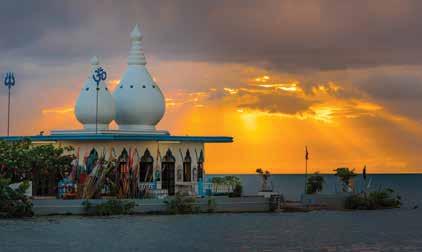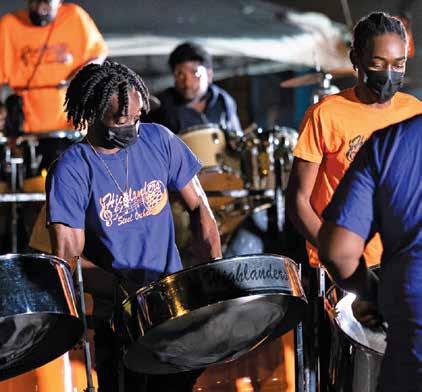
3 minute read
Truly Trinbagonian
12 Things that are Truly Trinbagonian
By Anna Walcott-Hardy
To label Trinidad and Tobago as unique is an understatement, the islands are buzzing with an indescribable energy. A callaloo-mix of cultures, T&T is home to 1.2 million people, many of whom welcome the challenge of changing adversity into an accomplishment. The fusion of food, festivals and music makes these islands like no other place on earth.
Liming
This is our Trinbagonian way of relaxing and having fun! Whether it’s a couple of friends catching-up at a bar, home entertaining, or partying sea-side, a lime with good friends always include great food and lots of “ole talk”.
Paramin Blue Devils
Bathed in blue these traditional characters emerge at sunset from the hills of Paramin on Carnival Monday to spew flames and wreak havoc on a gleeful crowd of spectators waiting at the crossroads. Words of warning – make sure to pay when the devils ask for a dollar!


Pan Yards
The steel pan was created from oil drums in Trinidad in the 1930s by innovators like Winston ‘Spree’ Simon, Ellie Mannette, Bertie Marshall and Anthony Williams. Steel pan yards are central to communities throughout the island. Many locally crafted percussive instruments were once banned by the colonial government including the Tamboo Bamboo. And yet the community of panmakers, players and tuners thrived in Belmont. Today, panyards can be found across the country, the bands welcome players from far and wide with many yards offering seating and refreshments.
FROM TOP No Man’s Land
Photo: Ziad Joseph Temple In The Sea
Photo: Ziad Joseph Scarlet Ibis at the Caroni Swamp
OPPOSITE PAGE FROM TOP Curried Crab & Dumplin’
Photo: Damian Luk Pat Highlanders Steel Orchestra
Doubles
Breakfast will never be the same once you’ve tried this popular Trinidadian street food. Two golden baras are filled with curried channa/chickpeas and a selection of delicious chutneys, with pepper being optional – we suggest ‘slight’ for the novices.
Red Topaz Hummingbird
There’s a reason Trinidad is called the land of the hummingbird. With 18 species, the Red Topaz is certainly one of the most majestic - just 8.1cm long including its tail, this iridescent beauty flaunts a ruby-red crown and shiny golden throat. The females are not as bright and colourful as the males, but the Trinidad and Tobago bird boasts a greenish-orange stripe from the chin to the chest.
Bamboo Cathedral
On the Chaguaramas peninsula, the scenic walk uphill through a natural arch of bamboo is a sight to behold. Serene, with picturesque ocean vistas of the north-west coast of Trinidad; if you’re lucky, you may also see the capuchin monkeys climbing the crisscrossed tree trunks.
The Nylon Pool
Once you enter the cerulean waters you won’t want to leave this natural, in-sea shallow pool, located near to the Buccoo Reef, Tobago. The warm waters and white-coral sands were named by Princess Margaret when she visited Tobago in 1962.


Curried Crab & Dumplin’
A visit to Store Bay will give you a chance to taste this traditional Tobagonian dish of curried Caribbean Blue Crab flavoured with cumin, coconut milk and cilantro. Highly recommended after a tour of Buccoo Reef and the Nylon Pool.
The Temple In The Sea
In Carapachaima, the original Hindu shrine was built by a determined devotee, Siewdass Sadhu. Although the original structure has been reconstructed, it still stands as a testament of love and perseverance.
The Magnificent Seven
Along the westerly side of the Queen’s Park Savannah, you can’t help but admire the dramatic Magnificent Seven historical buildings starting with the Queen’s Royal College (QRC) and ending with Castle Killarney (tours are recommended).
The Pitch Lake
In La Brea lies the greatest natural deposit of asphalt in the world, estimated at 10 million tonnes. Often called the eighth wonder of the world, there are over 109 acres of pitch where you can walk along the hissing surface and during the rainy season you can even bathe in pools that form.
Scarlet Ibis
The Caroni Swamp is a 12,000-acre sanctuary of mangroves, teeming with crabs, caiman and birds, with the grande finale being the arrival of the Scarlet Ibis at sunset. The boat tours begin at 4 pm, and although the birds are seen throughout the year, from mid-October to March is the best time to view the magnificent Ibis coming home to roost.










